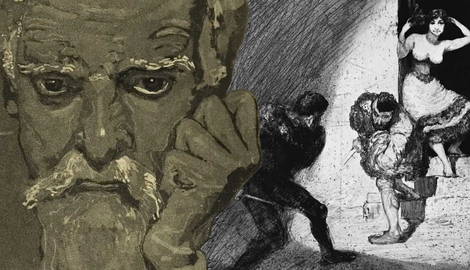
Max Klinger’s art drew inspiration from various sources. A prolific and multifaceted artist interested in all things intellectual, Klinger was also inspired by Charles Darwin’s The Origin of Species (1859). Before we explore four examples, let’s take a closer look at the influence of Darwin on Klinger.
Who Is Max Klinger?

Max Klinger was born in Leipzig on 18th February 1857 to a well-to-do family and began to study drawing at a young age. He studied in Karlsruhe and at the the Royal Academy of Art in Berlin, where, he got acquainted with the works of Adolph Menzel, who became one of his early inspirations. He continued his education in 1879 in Brussels as a pupil of Emile Charles Wauters. There, he experimented with printmaking, producing drawings that he later reinterpreted as etchings. After graduating, he began to produce drawings from life and nature, many of which related to his growing interest in the evolutionary theory of Charles Darwin. He grew ever more successful in the following decades, becoming a member of the Munich Academy. The Dresden Paintings Gallery became the first museum to buy one of his paintings (Pieta), and he was appointed professor at the Royal Academy of the Graphic Arts in Leipzig.
In 1883, Max Klinger moved to Paris. After acquiring a studio in the city, he immersed himself in the works of Francisco Goya, Honoré Daumier, and Puvis de Chavannes exhibited in the Louvre. On his return to Berlin in 1887, Klinger got acquainted with one of the paradigmatic figures of German Symbolism, Arnold Böcklin. He also studied and was influenced by Japanese art.

Between 1879 and 1910, he published no less than fourteen print series. In his essay “Malerei und Zeichnung” (Painting and Drawing), published in 1891, Klinger set out his ideas that painting should reflect the beauty of the visible world, while prints had the function of showing the “dark side of life.” His most important achievement in graphic arts is the two-part cycle On Death, published in 1889 and 1898. In the cycle, he addresses the phenomenon of death first from a microcosmic and then from a more comprehensive, macrocosmic point of view.
Max Klinger passed away on 5th July 1920, at the age of 63, in Grossjena, near the German city of Naumburg. Today, he is chiefly remembered for a stylistic blend of Jugendstil and Symbolism through which he expressed his dreamlike, gruesome, and grotesque visions. Thematically, his work goes from traditional historical paintings to bizarre etchings of dream-like visions. Concerned with the “dark side” of the human psyche and social problems, his etchings describe the life of 19th-century modern man. As a part of the Vienna Secession, Klinger contributed to the dissemination of the ideas of modern art in Germany before passing away in 1920.
Max Klinger & Darwinism

According to Marsha Morton’s “Impulses and Desires: Klinger’s Darwinism in Nature and Society” published at Nineteenth-Century Art Worldwide (2:1), Max Klinger had already been familiar with Darwinism from at least 1875 when he completed the drawing Darwinian Theory. While studying in Berlin, he wrote to his parents, requesting the exchange of their Darwinist material. The collected works of Darwin, with over two hundred illustrations, had been published in Germany the year prior and achieved great acclaim. The influence of a Darwinian worldview in Klinger’s art must be looked at beyond his references to natural history. Darwinism can be seen in his scenes of social criticism and his exploration of myth and dreams as vestiges of the primitive self. Like many German Darwinists, Klinger began his studies of nature and developed them into studies of contemporary society. Let’s take a closer look at 4 examples of Klinger’s Darwin-inspired works.
1. Siesta 1

Siesta 1 from Klinger’s first published print series, Etched Sketches, presents us with a scene of lobsters snoozing next to the remains of an eaten fish. The members of the better-adapted species relax after winning the daily struggle for survival. Darwin’s survival of the fittest at its most crude.
2. Pursued Centaur

Pursued Centaur appeared in Klinger’s 1881 series Intermezzos. Although this topic that blends myth with reality appears to have virtually no relationship with ideas of evolution, it actually is an excellent demonstration of the concept. The centaur appears doomed to become extinct, faced with a superior species that captures and rides horses. The scene is also blending a mythological, deep prehistory (centaur) with a familiar, present reality (rider with helmet).
3. Abduction

Extinct species like the Pterosaur that appears in Abduction appeared among others in Klinger’s series A Glove. Given the ongoing discussions regarding the process of revolution and its connection to the discoveries of dinosaur remains that took place during Klinger’s lifetime, it’s difficult not to see how this theme was connected to Klinger’s interest in Darwin. Distant progenitors of humans take a jump in time to haunt their distant successors on Earth. The echoes of the distant past, a past of majestic violence, meets its perfect match in the face of the most primal instinct; fear.
4. Bear and Elf

Just like with the Pursued Centaur from the same series, Bear and Elf is also a blending of myth with reality. In this work, we could say that Klinger presents us with a literal evolutionary scale. On the bottom, a bear, one of the most powerful predators in nature, is sitting on a tree branch while an elf, high on the tree, attempts to poke it in the nose with the help of a long stick. The elf, in perfect tune with nature, and perfectly adapted to its habitat, plays with the bear, a predator that is so far behind in the evolutionary scale that it poses virtually no threat to the elf. The bear can do nothing more than sit and take the gentle “hit”.










